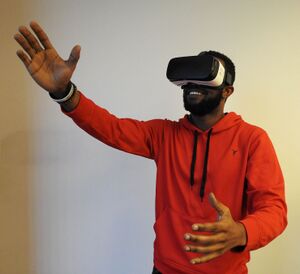Virtual Reality
Original Editor - Laura Tighe
Top Contributors - Laura Tighe
Introduction[edit | edit source]
Virtual reality (VR) can be defined as the “use of interactive simulations created with computer hardware and software to present users with opportunities to engage in environments that appear and feel similar to real-world objects and events”[1].
Virtual Reality enables the creation of a virtual environments in which immersion and interaction produce a sense of reality, where users engage and explore virtual environments in real-time. The content of these virtual environments can be created for specific purposes, such as gaming or education for example. The virtual reality technique is currently widely used in clinic and telerehabilitation[2].
Use as a Treatment Modality[edit | edit source]
The use of VR in healthcare is increasingly supported by research evidence. Examples include burn injury management[3], upper limb rehabilitation post stroke [4] and treatment of mental health disorders [5]. Immersive VR interventions may also have a role in musculoskeletal management and rehabilitation, although more research is needed to guide clinical practice[6].
Types of VR[edit | edit source]
Non-immersive VR
Allows the user to view and interact with a computer-generated image of themselves on a screen. The user can see and experience the real world outside of the screen and is not immersed completely in a virtual world [6]. An example would be a gaming console such as an Nintendo Wii.
Semi-immersive VR
A more advanced visual display (panoramic or curved screens to create a greater sense of immersion) is used. Similar to non-immersive technology, the user can see the real world either side of the screen.
Immersive VR
A headmounted display unit is used, this offers a multi-sensory experience for the user. Additional equipment may include; gesture-sensing gloves, wands, vibrotactile platforms and multidirectional treadmills. All this makes it possible for the user to explore and interact with the virtual world as an avatar (a virtual character that represents the individual within the virtual world)[6].
Embodiment is achieved when a user is immersed in VR and processes the avatar’s movements as though they are the users own body parts. To maximize this, the VR user must experience a sense of the following; location, agency (performing an action/ intervention that produces an effect) and body ownership (the user believes they are the avatar) [7].
Examples[edit | edit source]
Non-Immersive VR
This video shows a stroke patient using a non-immersive VR setup (Gaming Screen) to practice motor control. In this example the patient is playing a game of football, his leg movements are mirrored on screen.
Immersive VR
This video shows patients using immersive VR technology (Headset with motion sensors on hands to capture movement). It shows what the patient sees (the game /challenge they are performing) as well as them in reality with headset equipment on in the physiotherapy department. Patients give positive feedback on their experience.
Further Reading[edit | edit source]
Virtual Reality for Individuals Affected by Stroke
Virtual Reality and Parkinson's
Virtual Reality Treatment for Multiple Sclerosis
Virtual Reality As a Memory Aid in Cognitive Impaired Older adults
References[edit | edit source]
- ↑ Lucena-Anton, D.; Fernandez-Lopez, J.C.; Pacheco-Serrano, A.I.; Garcia-Munoz, C.; Moral-Munoz, J.A. Virtual and Augmented Reality versus Traditional Methods for Teaching Physiotherapy: A Systematic Review. Eur. J. Investig. Health Psychol. Educ. 2022, 12, 1780–1792.
- ↑ Ning Du, Ji-Guo Yu and YaFeng Song. A Brief Review of the Development of Telerehabilitation and its Application in Patients of Adolescent Idiopathic Scoliosis. Biomed J Sci & Tech Res 48(2)-2023. BJSTR. MS.ID.007634.
- ↑ Scapin S, Echevarria-Guanilo ME, Junior PRBF, et al. Virtual reality in the treatment of burn patients: a systematic review. Burns. 2018;44(6): 1403–1416.
- ↑ Laver KE, Lange B, George S, et al. Virtual reality for stroke rehabilitation. Cochrane Database Syst Rev. 2017;11:CD008349
- ↑ Maples-Keller JL, Bunnell BE, Kim SJ, et al. The use of virtual reality technology in the treatment of anxiety and other psychiatric disorders. Harv Rev Psychiatry. 2017;25(3):103–113
- ↑ 6.0 6.1 6.2 Brady, N., McVeigh, J.G., Mc Creesh, K., Rio, E., Dekkers, T.and Lewis, J.S. (2021) ‘Exploring the effectiveness of immersive virtual reality interventions in the management of musculoskeletal pain: a state-ofthe-art review’, available: https://hdl.handle.net/10344/10071
- ↑ Kilteni K, Groten R, Slater M. The sense of embodiment in virtual reality. Presence Teleoper Virtual Environ. 2012;21(4):373–387







